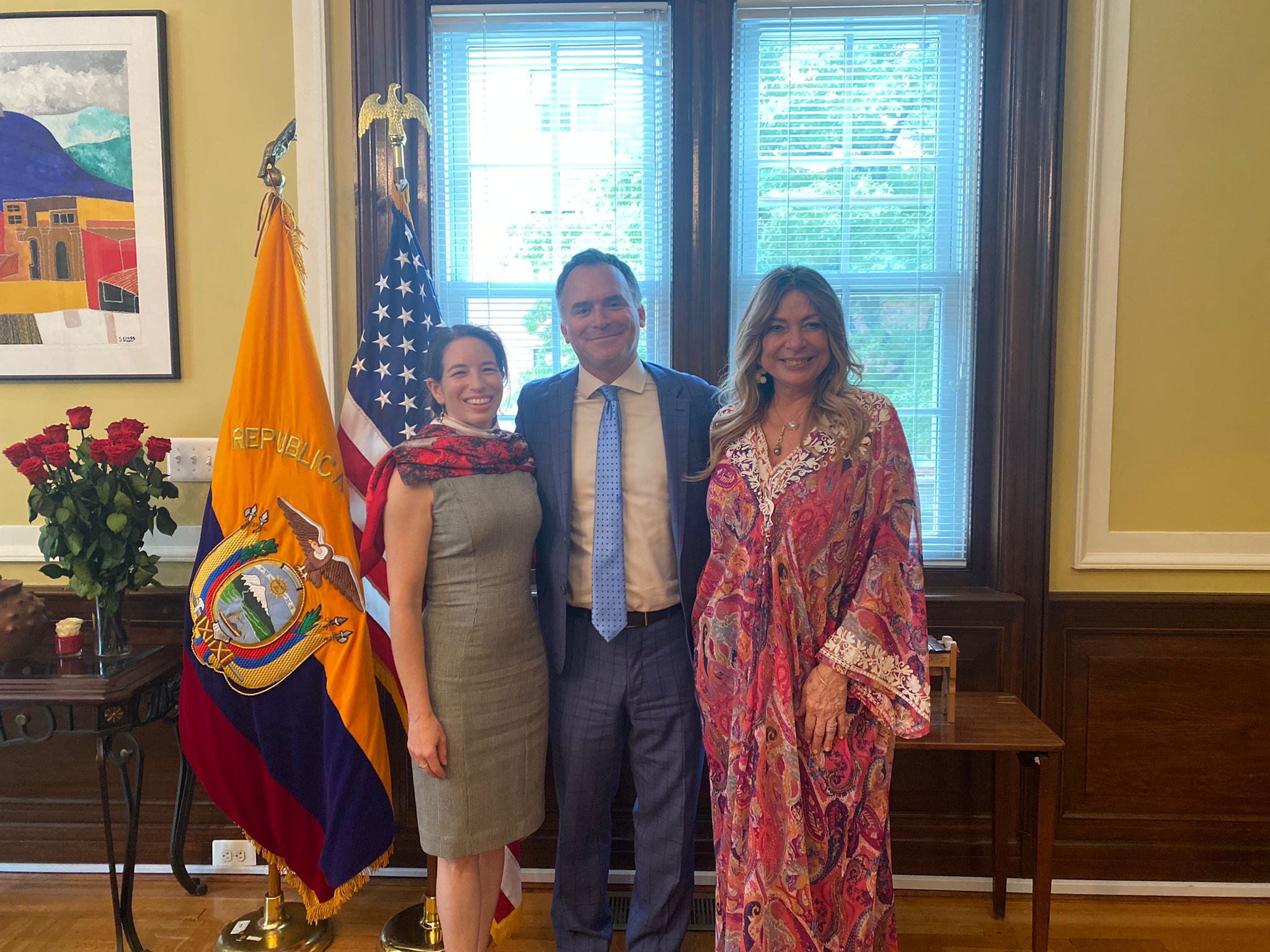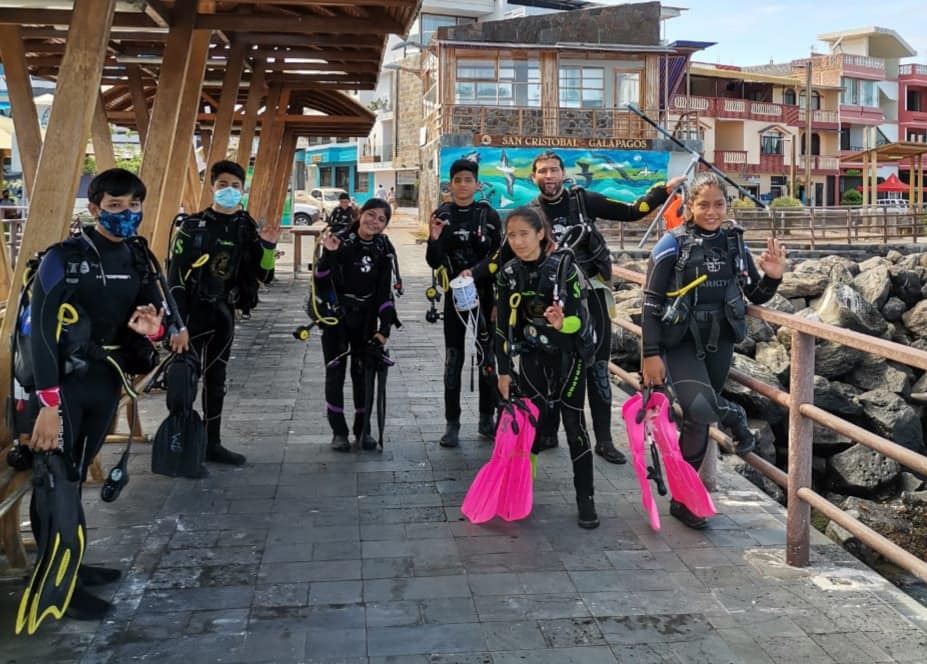In January 2022, the Galápagos Marine Reserve was expanded by 60,000 square kilometers, bringing the total area to 198,000 square kilometers. Created in 1998, the space is home to one of the most diverse marine ecosystems in existence, with species ranging from whale sharks to Pacific Green Turtles to Galápagos penguins.

(L to R) Deena Weisberg, Assistant Professor of Psychological and Brain Sciences at Villanova University; Michael Weisberg, Bess W. Heyman President's Distinguished Professor of Philosophy; and Ivonne Baki, Ecuador's Ambassador to the United States
The reserve is also unique due to the fact that it brings together the governments of Ecuador, Costa Rica, Panama, and Colombia in an allied effort to stave off illegal fishing practices, such as shark finning. It’s a remarkable achievement says Michael Weisberg, Bess W. Heyman President's Distinguished Professor of Philosophy, who has been involved in research and activism in the islands for much of his career.
“These are places that are unique in the world and we're losing them because of climate change and overfishing,” says Weisberg, author of Galápagos: Life in Motion. “And it's easy to say that we prioritize these things, but to actually try to do it shows real leadership.”
The Galápagos Islands are famed for their biodiversity. They were the site of inspiration for Charles Darwin’s development of his theory of evolution and continue to be an ideal location for research. To this end, the Galápagos Education and Research Alliance, or GERA, which Weisberg co-directs, aims to support Galápagos communities in protecting biodiversity, building resilience against climate change, and promoting the health of humans and non-humans alike. GERA brings together an alliance of the Galápagos community with faculty and students from across Penn, along with partners at Villanova University, Virginia Tech, and the University of Cincinnati.
The initiative’s work focuses on addressing the most pressing issues facing the islands: How can population growth continue while preserving the biodiversity for which Galápagos is justly famous? How can these communities prepare for the coming climate emergency? And how can the tools of community science be used to increase civic engagement with these issues and empower the local community to protect its home?
GERA approaches these goals on multiple fronts, including green business consulting, community outreach, public health, and urban development. LAVA, short for Laboratorio para Apreciar la Vida y el Ambiente, is a series of community science initiatives that address issues at the intersection of ecology, conservation, and education. These initiatives include LAVA-Lobos, which investigates the impact of human presence on the behavior and social structure of the endangered Galápagos Sea Lion; LAVA-Mar, which trains local middle schoolers to SCUBA dive and carry out scientific diving protocols; and LAVA-Agua, a project to study the domestic water supply.

A team of local divers investigates the health of the local marine ecosystem as part of GERA's LAVA-MAR project.
“As a marine biologist, I'm encouraged by the commitment to expand the reserve into a large wildlife corridor, since it covers an incredibly diverse marine environment supporting many different ecosystems,” says Luella Allen-Waller, a graduate student in biology who studies symbiotic corals and how they rely on microscopic algae for energy.
Allen-Waller says the bigger and more contiguous marine protected areas have outsized conservation benefits because they provide nurseries and refuges for wide-ranging species. “My goal in working with GERA is to develop community science initiatives that ignite curiosity and help people engage with the incredible ecosystem in their backyard. When conservation steps like this one are well-supported, they can start positive feedback cycles of engagement, which in turn brings more people to the table to help shape tomorrow's conservation efforts.”
Lia Enriquez, C'24, says the expansion is also important in the way it considers local citizens and the economy. “It is a policy that does not target the subsistence activities of Galápagos fishermen, which has been a big critique of a lot of environmental regulations on the islands.” Enriquez also emphasizes the challenge of preventing illegal fishing. “It is an open secret at this point that large fishing operations sneak through the border to access fisheries, affecting endangered species that are very sensitive to becoming bycatch (a term that refers to a marine species that is caught unintentionally, and often discarded).
Ambassador Ivonne Baki, Ecuador's Ambassador to the United States, says the expansion is momentous, and a bridge to future developments.
“It's historic what we have done in Galápagos,” says Baki, who was instrumental in forming the Galápagos Conservancy Foundation after an oil spill in 2000 threatened marine life in the region. “I think the announcement was something that people were not expecting to happen because it's difficult to get together the environmental part with the fishing industry to agree on that.”
“I think the announcement was something that people were not expecting to happen because it's difficult to get together the environmental part with the fishing industry to agree on that.”
Baki points out that while those in the fishing industry might lose out on some of their profits short term, protected areas eventually yield larger, healthier fish, not only within the reserve, but also in areas where commercial fishing is permitted.
In the future, the goal is to unite even more countries around the goal of protecting the ecosystem. “Now, it's almost 200,000 square kilometers of the protected area,” says Baki. “But when you add in Colombia, Panama, and Costa Rica it becomes 500,000—300,000 more. So, if other countries join, like Mexico, Peru, and Chile, we can expand it more and it'll be a protected area of the whole Pacific.”
For Weisberg and his students, it's all about forging ahead with research and community outreach, and future expansion only provides more fertile ground for discovery. “I think prioritizing large areas of ocean that are far from where people live is politically very difficult , but you have to do it, or you just end up just protecting the places that are highly visible,” says Weisberg. “It's similar to managing a city—sometimes what you have to do is the stuff no one sees, like replace the sewers and the water mains. But no mayor wants to run on, 'I'm going to dig up all the streets and replace all the sewers.' It's not sexy. So, that's why I think this expansion is so impressive and says a lot about the Ecuadorian government’s commitment to marine biodiversity protection.”


